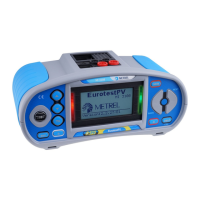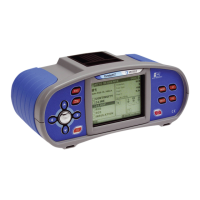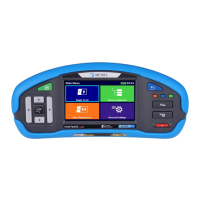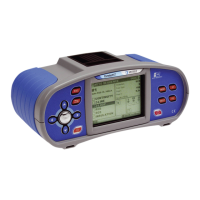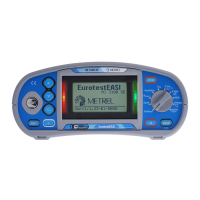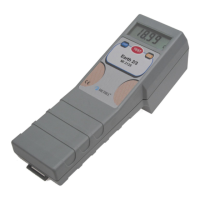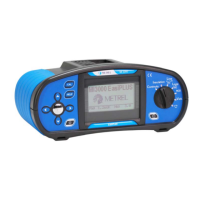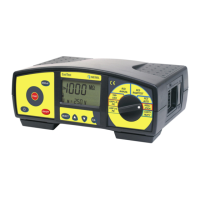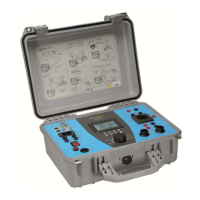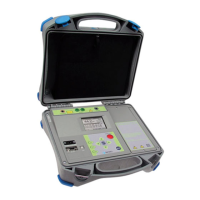Do you have a question about the METREL Eurotest 61557 and is the answer not in the manual?
Overview of the Eurotest 61557 test instrument's features and capabilities.
Crucial safety warnings and precautions for operating the instrument safely.
Details the various electrical parameters the instrument can measure.
Lists the European safety and EMC standards the instrument complies with.
Identifies and explains the buttons, display, and controls on the instrument's front panel.
Details the various input/output connectors and their functions on the instrument.
Describes features and components located on the bottom of the instrument.
Lists the standard accessories included with the instrument.
Lists optional accessories available for purchase.
Illustrates and describes different methods for carrying the test instrument.
Specifies the necessary accessories for performing particular measurements.
Step-by-step guide on how to perform insulation resistance measurements with the instrument.
Instructions for testing the breakdown voltage of varistor over-voltage protection devices.
Detailed procedure for measuring the continuity of protective conductors.
Guidance on using the instrument as a general ohmmeter for continuity tests.
Instructions for measuring Earth Resistance using the instrument's internal generator.
How to measure Earth Resistivity using the four-lead method.
Procedure for testing the PE terminal for phase voltage presence and conductor reversal.
How to measure contact voltage and fault loop resistance without tripping RCDs.
Step-by-step guide to measure the trip-out time of Residual Current Devices (RCDs).
Instructions for measuring the tripping current of RCDs at different fault currents.
Guide to performing a complete RCD test set automatically.
How to measure fault loop impedance and calculate prospective short-circuit current.
Measuring contact voltage under prospective short-circuit current conditions.
How to measure line impedance and calculate prospective short-circuit current.
Procedure for measuring N-PE loop resistance and prospective short-circuit current.
How to determine the phase sequence in a three-phase system.
Instructions for measuring AC current using a clamp or the instrument's input.
How to measure illumination levels using a LUXmeter probe.
Methods for tracing electrical conductors within an installation.
How to measure active, apparent, and reactive power and power factor.
Instructions for measuring electrical energy consumption over a set period.
How to measure voltage and current harmonics, including total harmonic distortion (THD).
How to adjust instrument settings like display contrast, date, and communication parameters.
Explains how to organize and name measurement locations for results.
Guide on how to save measurement results to the instrument's memory.
Procedure for retrieving and displaying previously saved measurement results.
Methods for deleting stored test results from the instrument.
How to reset the instrument's parameters to their factory default values.
Instructions on checking, replacing, and maintaining the instrument's batteries.
Information on the instrument's fuses, their ratings, and troubleshooting based on fuse issues.
Guidelines on how to clean the instrument's exterior safely and effectively.
Recommendations for the frequency of instrument calibration to ensure accuracy.
Information on how to obtain service or repairs for the instrument.
Detailed technical specifications and accuracy for each measurable function.
Overview of the instrument's general characteristics, power, environment, and connectivity.
Overview of the Eurotest 61557 test instrument's features and capabilities.
Crucial safety warnings and precautions for operating the instrument safely.
Details the various electrical parameters the instrument can measure.
Lists the European safety and EMC standards the instrument complies with.
Identifies and explains the buttons, display, and controls on the instrument's front panel.
Details the various input/output connectors and their functions on the instrument.
Describes features and components located on the bottom of the instrument.
Lists the standard accessories included with the instrument.
Lists optional accessories available for purchase.
Illustrates and describes different methods for carrying the test instrument.
Specifies the necessary accessories for performing particular measurements.
Step-by-step guide on how to perform insulation resistance measurements with the instrument.
Instructions for testing the breakdown voltage of varistor over-voltage protection devices.
Detailed procedure for measuring the continuity of protective conductors.
Guidance on using the instrument as a general ohmmeter for continuity tests.
Instructions for measuring Earth Resistance using the instrument's internal generator.
How to measure Earth Resistivity using the four-lead method.
Procedure for testing the PE terminal for phase voltage presence and conductor reversal.
How to measure contact voltage and fault loop resistance without tripping RCDs.
Step-by-step guide to measure the trip-out time of Residual Current Devices (RCDs).
Instructions for measuring the tripping current of RCDs at different fault currents.
Guide to performing a complete RCD test set automatically.
How to measure fault loop impedance and calculate prospective short-circuit current.
Measuring contact voltage under prospective short-circuit current conditions.
How to measure line impedance and calculate prospective short-circuit current.
Procedure for measuring N-PE loop resistance and prospective short-circuit current.
How to determine the phase sequence in a three-phase system.
Instructions for measuring AC current using a clamp or the instrument's input.
How to measure illumination levels using a LUXmeter probe.
Methods for tracing electrical conductors within an installation.
How to measure active, apparent, and reactive power and power factor.
Instructions for measuring electrical energy consumption over a set period.
How to measure voltage and current harmonics, including total harmonic distortion (THD).
How to adjust instrument settings like display contrast, date, and communication parameters.
Explains how to organize and name measurement locations for results.
Guide on how to save measurement results to the instrument's memory.
Procedure for retrieving and displaying previously saved measurement results.
Methods for deleting stored test results from the instrument.
How to reset the instrument's parameters to their factory default values.
Instructions on checking, replacing, and maintaining the instrument's batteries.
Information on the instrument's fuses, their ratings, and troubleshooting based on fuse issues.
Guidelines on how to clean the instrument's exterior safely and effectively.
Recommendations for the frequency of instrument calibration to ensure accuracy.
Information on how to obtain service or repairs for the instrument.
Detailed technical specifications and accuracy for each measurable function.
Overview of the instrument's general characteristics, power, environment, and connectivity.
| Brand | METREL |
|---|---|
| Model | Eurotest 61557 |
| Category | Test Equipment |
| Language | English |
